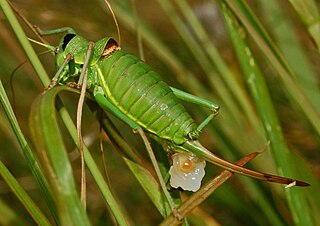
The Acrididae are the predominant family of grasshoppers, comprising some 10,000 of the 11,000 species of the entire suborder Caelifera. The Acrididae are best known because all locusts are of the Acrididae. The subfamily Oedipodinae is sometimes classified as a distinct family Oedipodidae in the superfamily Acridoidea. Acrididae grasshoppers are characterized by relatively short and stout antennae, and tympana on the side of the first abdominal segment.

The genus Coenobita contains 17 species of terrestrial hermit crabs.

Bandwings, or band-winged grasshoppers are the subfamily Oedipodinae of grasshoppers classified under the family Acrididae. They have a worldwide distribution and were originally elevated to full family status as the Oedipodidae. Many species primarily inhabit xeric weedy fields, and some are considered to be important locusts:

The grasshopper subfamily Acridinae, sometimes called silent slant-faced grasshoppers, belong of the large family Acrididae in the Orthoptera: Caelifera.

The Cimicomorpha are an infraorder of insects in the order Hemiptera, the true bugs. The rostrum and other morphology of all members apparently is adapted to feeding on animals as their prey or hosts. Members include bed bugs, bat bugs, assassin bugs, and pirate bugs.

Micrommata is a genus of huntsman spiders that was first described by Pierre André Latreille in 1804.

Atypus, also called purseweb spiders, is a genus of atypical tarantulas first described by Pierre André Latreille in 1804. It occurs in Eurasia, with one species reaching into North Africa, and one species in the USA. Only three of the described species occur in Europe: A. piceus, A. affinis, and A. muralis.

Delphacidae is a family of planthoppers containing about 2000 species, distributed worldwide. Delphacids are separated from other "hoppers" by the prominent spur on the tibia of the hindleg.

Berytidae is a family of the order Hemiptera, commonly called stilt bugs or thread bugs.

The Phalangiidae are a family of harvestmen with about 380 known species. The best known is Phalangium opilio. Dicranopalpus ramosus is an invasive species in Europe.

Pyrgomorphidae is a family of grasshoppers in the order Orthoptera; it is the only family in the superfamily Pyrgomorphoidea, with a pan-tropical distribution. Their name is probably derived from pyrgos meaning "tower": a reference to the form (morph) of the head in the type genus Pyrgomorpha and other genera.

Oedipoda is the type genus of grasshoppers, in the subfamily Oedipodinae. Species include the European "blue-winged grasshopper", Oedipoda caerulescens.

Ephippiger is a bush cricket genus described by Berthold in 1827, belonging to the family Tettigoniidae, subfamily Bradyporinae and tribe Ephippigerini.

Aiolopus is a genus of grasshopper belonging to the family Acrididae, subfamily Oedipodinae and tribe Epacromiini. Species can be found in Africa, Europe and Asia - through to New Caledonia.

Tytthus is a genus of insects in family Miridae, the plant bugs. They are carnivorous, feeding upon the eggs of various planthoppers in the family Delphacidae, and thus are important in the biological control of pests. The genus is distributed throughout the Holarctic of the Northern Hemisphere, but species are also found in the tropics, in China, South America, Australia, and the Indo-Pacific.

Calephorus compressicornis is a species of grasshopper in the tribe Calephorini found in Europe and Africa.

Heriaeus is a genus of crab spiders that was first described by Eugène Louis Simon in 1875.

The Pyrgomorphinae are a sub-family of grasshoppers in the family Pyrgomorphidae. Species are found in, especially the warmer parts of: Central and South America, southern Europe, Africa, Asia, Australia and Pacific Islands. The type genus is Pyrgomorpha and names dates from "Pyrgomorphiden" by Brunner von Wattenwyl, 1874. The first use of Pyrgomorphinae was by Krauss in 1890.

Tridactylus is a genus of pygmy mole crickets, with species recorded from Africa, India, Indo-China and Australia.

The Tettigometridae are a family of Fulgoromorpha (planthoppers), with a species distribution from: Europe, Africa, Asia through to west Malesia.



















